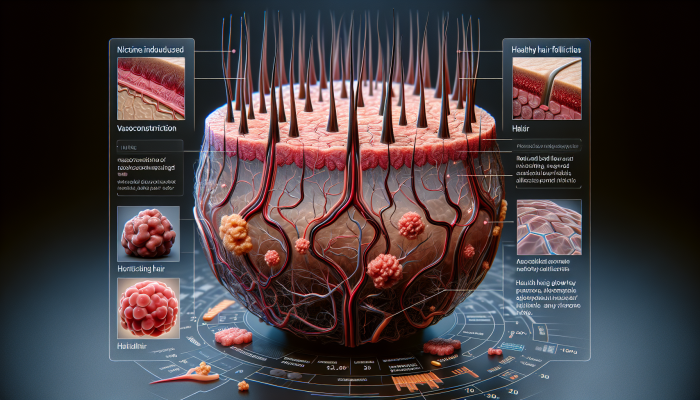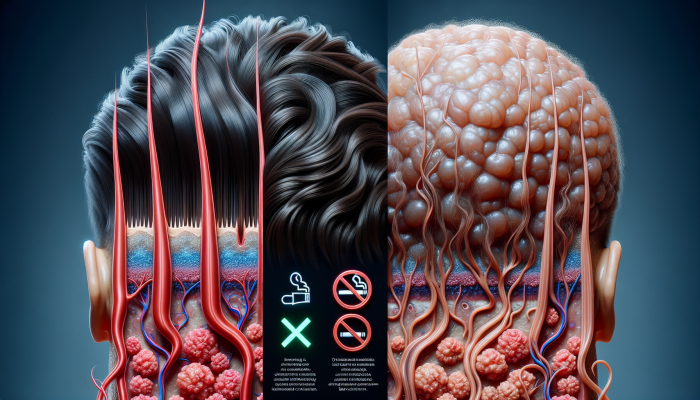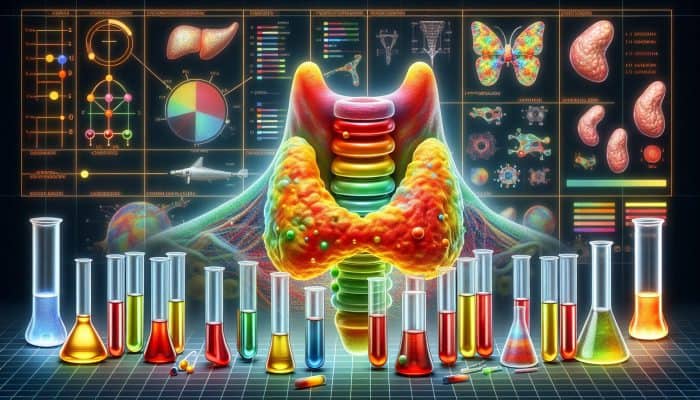Unveiling the Detrimental Effects of Smoking on Hair Growth and Health
Smoking is well-known for its negative impact on overall health, but the implications for hair health are particularly alarming. The myriad of toxic chemicals found in cigarette smoke can severely compromise hair follicles, initiating a series of adverse effects that impede healthy hair growth. Delving into these mechanisms is crucial for anyone looking to boost their hair vitality, particularly those who currently smoke or have smoked in the past. By understanding the integral link between smoking and hair health, individuals can take proactive steps to enhance the condition of their hair and improve their overall wellness.
Discovering the Effects of Nicotine on Blood Flow and Hair Follicle Function

Nicotine, the primary addictive component in cigarettes, is infamous for its capacity to induce vasoconstriction, which significantly disrupts blood circulation to hair follicles. This impeded blood flow limits the delivery of essential nutrients and oxygen vital for their survival and growth. Healthy hair follicles require a consistent supply of nutrients to thrive; when this nutrient flow is obstructed, hair growth can slow considerably. Many smokers experience noticeably lower hair growth rates compared to non-smokers, highlighting the damaging influence of nicotine on hair vitality.
The consequences of nicotine’s impact on blood circulation extend beyond simply limiting nutrient supply. Inadequate blood flow can hinder hair follicles’ ability to effectively remove waste products, leading to a build-up of toxins that creates an unfavourable environment for hair growth. This accumulation of toxic substances can contribute to hair thinning and, ultimately, hair loss. The intricate nature of these interactions underscores the profound impact of smoking on hair health, revealing both immediate and enduring consequences for those affected.
Moreover, research indicates that chronic smoking may result in irreversible alterations to the functioning of hair follicles. The persistent presence of nicotine can disrupt the natural cycles of hair growth, pushing more hair into the telogen (resting) phase while simultaneously limiting the number of follicles actively producing hair. As a result, the cumulative effects of nicotine can be devastating for those looking to maintain or improve their hair health over time.
Understanding the Role of Oxidative Stress in Accelerated Hair Loss
The established connection between smoking and oxidative stress is well supported by scientific literature. Cigarette smoke is replete with free radicals, which can inflict extensive damage on cells throughout the body, including the delicate cells located within the scalp. This surge in oxidative stress severely disrupts hair follicles, leading to cellular dysfunction and an increased rate of hair loss, which poses a significant concern for anyone focused on sustaining their hair health.
As oxidative stress levels rise due to smoking, hair follicles become increasingly vulnerable to damage. Studies indicate that heightened oxidative stress can instigate inflammation and apoptosis (cell death) within hair follicles, exacerbating issues of thinning hair and hair loss. The cumulative outcomes of these processes illustrate how smoking can perpetuate a damaging cycle of poor hair health, making it a vital area of concern for those worried about their hair condition.
Additionally, the ramifications of smoking on oxidative stress not only affect hair growth but also detract significantly from the overall quality of hair. Compromised hair follicles produce strands that are weak and prone to breaking, further complicating the issues faced by smokers who may already be battling diminished hair health. By actively addressing oxidative stress through lifestyle modifications or smoking cessation, individuals can experience remarkable improvements in their hair’s vitality and overall appearance.
Investigating the Impact of Hormonal Imbalances Induced by Smoking on Hair Loss
Hormones are crucial in regulating hair growth, and smoking can disrupt the delicate balance of these hormones. The impact of smoking on hormonal levels can lead to conditions like androgenetic alopecia, a prevalent form of hair loss characterised by thinning hair on the scalp. This disruption arises due to smoking’s interference with adrenal and sex hormones, which can disrupt the natural hair growth cycle.
Research has shown that smoking can elevate levels of dihydrotestosterone (DHT), a potent androgen associated with hair loss. Increased DHT levels can lead to the miniaturisation of hair follicles, causing them to produce thinner, weaker strands of hair. For those genetically predisposed to hair loss, smoking can serve as a significant exacerbating factor, hastening the onset and progression of this condition.
The hormonal fluctuations linked to smoking can also disrupt the various phases of hair growth, potentially forcing more hair into the telogen (resting) phase prematurely. This alteration often results in excessive shedding, compounding the challenges smokers face regarding their hair health. Understanding the connection between smoking and hormonal imbalances is critical for individuals aiming to comprehend and combat hair loss effectively.
Highlighting the Importance of Scalp Circulation for Optimal Hair Growth

Maintaining optimal scalp circulation is vital for supporting healthy hair follicles and promoting vigorous hair growth. The vasoconstrictive properties associated with smoking lead to reduced blood flow to the scalp, adversely affecting its overall health and vitality. This reduced circulation can obstruct the delivery of essential nutrients and oxygen, both crucial for fostering active hair follicles and encouraging strong hair growth.
When blood flow to the scalp is compromised, hair follicles may lack the necessary support needed to thrive. This insufficiency can lead to various complications, including hair thinning and an increased vulnerability to environmental stressors. The impact of smoking on hair health is thus exacerbated by this decline in circulation, making it increasingly challenging for smokers to maintain a robust and healthy head of hair.
Moreover, insufficient circulation can hinder the natural processes that sustain scalp health. A well-circulated scalp is essential for supporting cellular regeneration and preserving a balanced environment. Without proper blood flow, the scalp may become dry, flaky, or even inflamed, further compounding the difficulties associated with hair loss. For smokers, recognising the importance of scalp health and circulation is crucial in reversing the negative impacts linked to their smoking habits.
Understanding Toxin Accumulation in Hair and Its Implications
The noxious toxins found in cigarette smoke can accumulate within the hair shaft, ultimately leading to a decline in overall hair health. Hair naturally acts as a reservoir for various substances, including the multitude of harmful chemicals present in cigarettes. Over time, this toxin build-up can threaten the structural integrity of hair, rendering it more susceptible to breakage and loss.
As hair becomes increasingly saturated with toxins, its ability to retain moisture diminishes considerably. This can manifest as hair that is dry and brittle, devoid of vitality and shine. Smokers may observe that their hair not only becomes more fragile but also loses the lustrous appearance typically associated with healthy hair. These aesthetic changes are frequently a direct result of the impact of smoking on hair health.
Furthermore, the presence of these toxins can significantly reduce the effectiveness of hair care products. When hair suffers due to the accumulation of harmful substances, it may become less responsive to treatments and products specifically designed to nourish and restore health. This frustrating cycle can lead to increased dissatisfaction for individuals striving to improve their hair’s condition, as the very products intended to assist may become far less effective.
Evaluating the Negative Consequences of Smoking on Hair Quality
The overall quality of hair is influenced by various factors, including lifestyle choices, environmental stressors, and general health. Among these, smoking has been shown to adversely affect hair quality, leading to a range of negative outcomes that can impact both appearance and health.
Investigating the Relationship Between Smoking and Hair Dryness and Brittleness

One of the most immediate consequences of smoking on hair quality is the increased dryness and brittleness that affects the hair structure. The toxic compounds present in cigarette smoke can strip hair of its natural oils, resulting in a deficiency in moisture and essential nutrients. This depletion leaves hair feeling coarse and rough, making it more susceptible to snapping under minimal strain.
The drying effects of smoking are not merely superficial; they can lead to long-term damage over time. Without adequate moisture, hair loses its elasticity and becomes increasingly vulnerable to breakage. Smokers often report that their hair does not respond well to styling or treatments, as the necessary structural integrity for healthy hair is compromised. This detrimental impact of smoking on hair health can create a frustrating cycle of damage and repair that proves difficult to overcome.
Moreover, the increased brittleness can dictate a series of effects on styling choices. Smokers may feel compelled to limit their styling options, opting for less damaging techniques that may prolong the lifespan of their hair. However, the underlying issues remain unresolved, often necessitating a more comprehensive and holistic approach to hair care.
Understanding Increased Hair Porosity Induced by Smoking
Smoking can also lead to increased hair porosity, which refers to the hair’s ability to absorb and retain moisture effectively. Hair with elevated porosity is more vulnerable to damage from environmental factors, such as humidity and pollution, as well as from various styling products. The toxins present in cigarette smoke can alter the hair cuticle, rendering it more porous and less capable of protecting itself from external aggressors.
When hair becomes more porous, it tends to absorb moisture quickly; however, it also loses that moisture just as swiftly. This fluctuation creates an unstable environment for maintaining hair health, often resulting in frizz and uneven texture. Smokers might notice that their hairstyles do not hold as well, as the increased porosity diminishes the hair’s ability to maintain shape and form effectively.
Managing high porosity hair typically requires a targeted approach involving specialised products designed to strengthen and protect the hair. Smokers may find themselves increasingly reliant on conditioners and treatments to mitigate the effects of porosity, resulting in greater product dependency and expense. This reality underscores the significant impact of smoking on hair health, as it can generate a variety of challenges that necessitate ongoing attention and care.
Examining the Link Between Smoking and Premature Greying
Research has indicated a correlation between smoking and premature greying of hair, a concern that resonates with many individuals. The mechanisms involved include the damage inflicted by cigarette smoke on melanin-producing cells within hair follicles. Melanin is responsible for imparting colour to hair, and when its production is disrupted, premature greying can ensue.
The oxidative stress induced by smoking plays a pivotal role in this process. Free radicals generated from smoking can harm melanocytes, the cells responsible for producing melanin, thereby accelerating the greying process. Smokers may find themselves noticing grey hairs at an earlier age than non-smokers, which can significantly impact their self-image and confidence.
Interventions aimed at combating premature greying often involve addressing the root causes, such as quitting smoking, adopting healthier lifestyle habits, and incorporating antioxidant-rich foods into one’s diet. Recognising the impact of smoking on hair health is fundamental to reversing or reducing these effects and promoting a return to vibrant, youthful hair.
Understanding the Connection Between Smoking and Hair Loss
The alarming issue of hair loss and thinning is disturbingly common among smokers. As previously mentioned, smoking significantly impedes blood circulation to the scalp, directly affecting hair growth. When hair follicles are deprived of essential nutrients and oxygen, they may struggle to produce healthy hair, leading to increased shedding and thinning over time.
Research has demonstrated that smokers are more likely to experience hair loss compared to their non-smoking peers. This connection arises from various factors, including the effects of nicotine, oxidative stress, and hormonal imbalances discussed earlier. The cumulative impacts of these elements can result in a marked decline in hair density and volume, making it a pressing concern for smokers.
For those grappling with hair loss attributed to smoking, seeking support can be vital. This may involve consulting healthcare professionals, considering nutritional supplements, or exploring hair restoration options. Recognising the impact of smoking on hair health empowers individuals to make informed decisions regarding their hair care journey and take proactive steps toward improvement.
Investigating the Interrelationship Between Smoking and Scalp Health
While often overlooked, scalp health is integral to discussions about hair care; it plays a crucial role in the overall vitality and appearance of hair. Smoking introduces a host of challenges to maintaining scalp health, which can have direct consequences on hair growth and quality.
Addressing Inflammation and Irritation Induced by Smoking
One of the foremost concerns associated with smoking is its potential to provoke inflammation and irritation of the scalp. The toxic compounds present in cigarette smoke can trigger inflammatory responses, leading to conditions such as dandruff and seborrheic dermatitis. These scalp conditions can cause discomfort and create an unhealthy environment that obstructs proper hair growth.
Inflammation can disrupt the normal functioning of hair follicles, compromising the hair growth cycle. The irritation caused by smoking may manifest as itching, redness, and flaking, which significantly detracts from an individual’s overall hair health. Smokers may find themselves contending with various scalp issues that complicate their hair care efforts and impede progress.
Addressing inflammation requires a multifaceted approach, incorporating both smoking cessation and the use of anti-inflammatory scalp treatments in one’s routine. These measures can help restore balance to the scalp, fostering a more favourable environment for healthy hair growth. Recognising the impact of smoking on hair health is essential for anyone looking to enhance their overall scalp condition and hair vitality.
Examining the Detrimental Effects of Reduced Scalp Circulation
As previously highlighted, smoking leads to reduced blood circulation, which adversely affects scalp health. The vasoconstrictive nature of nicotine restricts the delivery of essential nutrients to the scalp, compromising the health of hair follicles and the surrounding skin. This impaired circulation can obstruct the natural processes necessary for healthy hair growth, resulting in various complications.
When blood flow is diminished, the scalp becomes less receptive to treatments and more susceptible to a range of issues, including dryness and irritation. The repercussions of poor scalp circulation extend beyond immediate discomfort; over time, they can contribute to a gradual decline in hair health and a heightened risk of hair loss. For smokers, enhancing scalp circulation is critical in reversing the damaging impact of smoking on hair health and fostering a thriving environment for hair growth.
Increased Risk of Scalp Infections Linked to Smoking
A compromised immune system is another consequence of smoking, which elevates the risk of infections affecting the scalp. Smokers may be more susceptible to fungal and bacterial infections, resulting in various scalp conditions that can hinder healthy hair growth. This heightened vulnerability can further complicate hair health, as infections can induce inflammation and damage to hair follicles.
Conditions such as folliculitis, characterised by the inflammation of hair follicles, can be exacerbated by the existing challenges posed by smoking. The presence of infections creates an unfavourable environment for hair, leading to excessive shedding and the possibility of scarring in the follicles. Smokers must remain vigilant regarding their scalp health to mitigate these risks and protect their hair from the detrimental effects associated with infections.
Preventive measures can include maintaining a clean scalp, utilising anti-fungal or anti-bacterial treatments when necessary, and addressing any underlying health issues. Acknowledging the impact of smoking on hair health is crucial for smokers who wish to preserve their hair and maintain their overall scalp condition.
Exploring the Positive Transformations Following Smoking Cessation for Hair Recovery
The journey towards improved hair health often commences with the decision to quit smoking. Although the cessation process may appear daunting, the positive effects on hair health can be substantial and transformative, leading to significant enhancements over time.
Boosting Blood Flow After Quitting Smoking
One of the most immediate benefits experienced upon quitting smoking is the enhancement of blood circulation to the scalp. As the body begins to recover from the detrimental effects of smoking, blood vessels can dilate, facilitating improved blood flow. This enhanced circulation fosters the delivery of essential nutrients and oxygen to hair follicles, promoting healthier hair growth.
With improved blood flow, hair follicles can regain their functionality, leading to a more vigorous hair growth cycle. Smokers may observe a gradual increase in hair density and volume as they begin to reap the benefits of enhanced circulation. The positive impact of smoking on hair health can be felt relatively quickly after quitting, providing motivation for individuals to continue their journey towards a smoke-free life.
In addition to superior circulation, quitting smoking can also bolster overall skin health, including the scalp. As the body undergoes detoxification, the scalp may experience reduced inflammation and achieve a more balanced state, contributing to a healthier environment for hair growth.
Reduction in Oxidative Stress After Quitting Smoking
Quitting smoking leads to a significant decrease in oxidative stress levels within the body. As the body begins to expel the toxins associated with cigarette smoke, the overall cellular environment experiences marked improvement. This reduction in oxidative stress can lessen the damage inflicted on hair follicles, promoting a healthier hair growth cycle.
Research suggests that individuals who quit smoking often experience lower levels of inflammation and enhanced cellular function, both of which are vital for maintaining hair health. Over time, the effects of quitting can manifest as visible improvements in hair quality, including increased thickness and diminished breakage.
Incorporating a diet rich in antioxidants can further bolster the recovery process. Foods abundant in vitamins C and E, along with omega-3 fatty acids, can help combat oxidative damage and nourish hair follicles. By actively addressing oxidative stress through lifestyle changes, individuals can amplify the beneficial impact of smoking on hair health and support long-term recovery.
Timeframe for Notable Hair Improvements Post-Smoking Cessation
The timeframe for observing visible improvements in hair health after quitting smoking can vary considerably among individuals. While some may begin to notice changes in hair thickness and vitality within a few months, others might experience a more extended recovery period. Factors such as genetics, overall health, and age can all influence the timing of hair recovery.
Generally, hair growth follows a cyclical pattern, meaning it may take several months for the benefits of quitting smoking to translate into visible changes. Nevertheless, the commitment to cessation can yield substantial rewards, including a healthier scalp environment and improved hair quality over time. Monitoring progress and practising patience are essential components of this transformative journey.
For those seeking to enhance their hair health, quitting smoking is a pivotal step toward achieving desired outcomes. The positive effects of cessation on blood flow, oxidative stress, and overall scalp condition can lead to meaningful improvements in hair growth and quality. Embracing this change can ultimately result in a more vibrant and luscious head of hair.
Exploring the Indirect Effects of Smoking on Hair Health
While the direct effects of smoking on hair health are considerable, a variety of indirect factors also exacerbate these issues. Gaining a comprehensive understanding of these broader implications can provide deeper insights into how smoking influences overall hair quality.
Examining How Smoking Contributes to Nutritional Deficiencies
Smoking can significantly disrupt nutrient absorption, leading to various deficiencies that adversely affect hair health. Essential vitamins and minerals, such as vitamin A, vitamin E, and biotin, are crucial for maintaining healthy hair. Smokers may find themselves at a heightened risk of deficiencies due to the negative effects of smoking on nutrient uptake.
This nutritional imbalance can manifest in multiple ways, including weakened hair, increased shedding, and slower growth rates. Smokers may need to take proactive steps to address these deficiencies by incorporating a more diverse array of nutrient-dense foods into their diets or considering supplements specifically tailored to support hair health.
Moreover, recognising the relationship between nutrition and hair health is critical for anyone aiming to improve their overall hair condition. Understanding the impact of smoking on hair health can inspire individuals to adopt healthier dietary practices that benefit both their hair and overall well-being.
Exploring the Interconnected Relationship Between Stress and Smoking
Smoking is commonly linked with elevated stress levels, creating a self-perpetuating cycle of adverse effects on hair health. Stress is a recognised contributor to hair loss, as it can trigger telogen effluvium, a temporary condition that results in excessive hair shedding. Smokers may find themselves ensnared in a loop where stress and smoking exacerbate one another, leading to persistent hair issues.
Proactively managing stress can yield significant benefits for hair health. Techniques such as meditation, exercise, and mindfulness can assist individuals in navigating the challenges of quitting smoking while simultaneously reducing stress levels. By addressing both the physical and emotional dimensions of smoking cessation, individuals can experience a more positive impact of smoking on hair health.
Understanding How Smoking Disrupts Sleep Patterns and Impairs Hair Health
Smoking can interfere with sleep patterns, leading to poor sleep quality that ultimately affects hair health. Inadequate sleep has been associated with various health problems, including hair loss and diminished hair quality. Smokers may encounter challenges such as insomnia or restlessness, exacerbating existing issues surrounding their hair health.
Enhancing sleep hygiene is crucial for anyone looking to improve their hair condition. Strategies may include developing a calming bedtime routine, limiting screen exposure before sleep, and establishing a consistent sleep schedule. Focusing on improving sleep quality can help mitigate the negative effects of smoking and create a more favourable environment for hair growth.
Recognising the impact of smoking on hair health enables individuals to adopt a holistic approach to their overall well-being. By addressing the interconnected factors that influence hair health, smokers can work towards achieving their hair goals while promoting their overall health and vitality.
Confronting Reduced Blood Circulation Due to Smoking
As previously discussed, the diminished blood circulation caused by smoking can directly impact hair health. This inadequate circulation deprives hair follicles of essential nutrients and oxygen necessary for healthy growth and vitality. The cumulative effects of poor circulation can lead to various challenges, including hair loss, thinning, and reduced overall quality.
Addressing blood circulation issues requires a commitment to lifestyle changes, including quitting smoking, maintaining a balanced diet, and engaging in regular physical activity. Incorporating exercises that enhance blood flow, such as cardiovascular workouts, can improve scalp circulation and encourage healthy hair growth. Understanding the impact of smoking on hair health empowers individuals to make informed choices that positively influence both their hair and overall well-being.
Examining the Interaction Between Smoking and Hair Care Products
The relationship between smoking and hair care products represents an often-overlooked aspect of hair health. The toxins present in cigarette smoke can significantly affect the efficacy of these products, as well as the hair itself.
Understanding the Reduced Efficacy of Hair Care Products for Smokers
The presence of toxins from cigarette smoke can severely compromise the effectiveness of hair care products. When hair is damaged by smoking, it becomes less receptive to treatments designed to nourish and repair its condition. This situation can create a frustrating experience for smokers who may rely on these products to manage their hair-related concerns.
Hair care products usually contain active ingredients that require healthy hair and scalp conditions to function optimally. When the hair has been compromised due to smoking, those ingredients may struggle to penetrate deeply or be absorbed effectively. Consequently, smokers may find themselves grappling with ongoing hair challenges despite their best efforts to utilise high-quality products.
Recognising the impact of smoking on hair health can motivate individuals to adopt a more targeted approach to hair care. This may involve selecting products specifically formulated for damaged hair or seeking professional guidance on treatments that can deliver greater benefits.
Understanding Increased Dependence on Hair Care Products
Due to the compounding issues created by smoking, many smokers experience an increasing reliance on hair care products to maintain their hair health. This dependency can lead to a cycle of continuous product use without addressing the underlying causes of hair issues, such as smoking.
In their quest for solutions to counteract the negative effects of smoking, individuals may turn to an assortment of products, ranging from shampoos to serums, in search of relief. However, without tackling the root causes—such as quitting smoking and adopting healthier lifestyle choices—the effectiveness of these products may remain limited.
This growing dependency underscores the importance for smokers to evaluate their hair care routines and consider modifications that address the core issues affecting their hair health. By acknowledging and confronting the impact of smoking on hair health, individuals can work towards reclaiming their hair vitality in a meaningful way.
Recognising the Potential for Allergic Reactions to Hair Care Products
The chemicals found in cigarette smoke can also increase the likelihood of experiencing allergic reactions to hair care products. Smokers may discover that their scalps become more sensitive and reactive to certain ingredients, resulting in discomfort or adverse reactions. This heightened sensitivity can complicate hair care routines and necessitate careful consideration of product choices.
Individuals might need to experiment with hypoallergenic or natural products to mitigate the risk of allergic reactions. Understanding how smoking can heighten sensitivities to hair care products is essential for those striving to maintain their hair health. By being mindful of the impact of smoking on hair health, smokers can make informed decisions that contribute to more favourable hair care outcomes.
Frequently Asked Questions About Smoking and Its Effects on Hair Health
How does smoking negatively influence hair growth?
Smoking can inhibit hair growth by restricting blood flow to hair follicles, increasing oxidative stress, and disrupting hormonal balance, all of which contribute to slower or stunted hair growth.
Can quitting smoking lead to improvements in hair health?
Indeed, quitting smoking can result in substantial enhancements in hair health, including improved blood circulation to the scalp, reduced oxidative stress, and overall better hair growth outcomes.
What adverse effects does smoking have on hair quality?
Smoking can result in dryness, brittleness, increased porosity, and premature greying of hair, significantly diminishing its overall quality and vitality.
How does smoking negatively affect scalp health?
Smoking can induce inflammation, reduce circulation, and increase the likelihood of scalp infections, all of which have detrimental effects on hair growth and quality.
What is the expected timeframe for hair recovery after quitting smoking?
Visible improvements in hair health can typically begin within months of quitting smoking, although full recovery may take a longer duration depending on individual factors, such as genetics and overall health.
Is hair loss a consequence of smoking?
Yes, smoking is associated with increased hair loss due to factors such as reduced blood circulation, oxidative stress, and hormonal imbalances that negatively affect hair follicles and growth.
What nutritional deficiencies are commonly linked to smoking and hair health?
Smoking can impair nutrient absorption, leading to deficiencies in essential vitamins and minerals crucial for maintaining healthy hair, such as vitamins A, E, and biotin.
How does smoking impact the effectiveness of hair care products?
The toxins present in cigarette smoke can diminish the effectiveness of hair care products by damaging hair structure and limiting the ability of active ingredients to penetrate effectively.
Can smoking disrupt sleep patterns and subsequently affect hair health?
Yes, smoking can disrupt sleep patterns, and poor sleep quality is correlated with various hair problems, including hair loss and diminished quality.
What steps can be taken to improve hair health after quitting smoking?
To enhance hair health following smoking cessation, focus on maintaining a balanced diet, staying well-hydrated, using quality hair care products, and incorporating scalp massages to stimulate circulation.
Connect with us on Facebook!
The Article: Impact of Smoking on Hair Health: A Comprehensive Overview appeared first on Amitys Hair Salon.
The Article Smoking’s Impact on Hair Health: A Detailed Guide Was Found On https://limitsofstrategy.com



